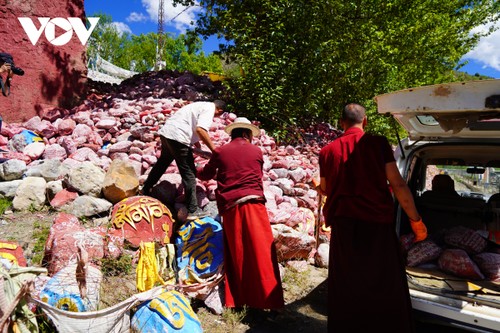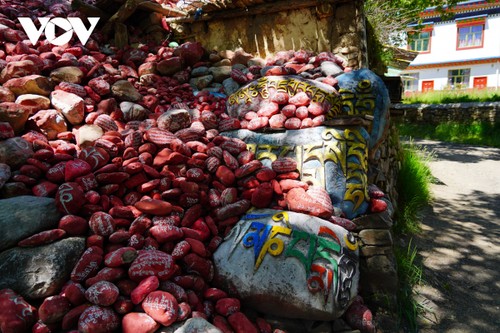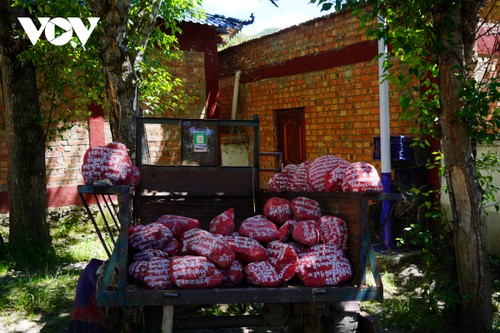 People bring their stones with carved prayer to a mani stone pile. People bring their stones with carved prayer to a mani stone pile.
|
Tibetans live in high mountain areas where stones can be found almost everywhere. Tibetan Buddhists believe that everything possesses spirituality, and, naturally, white stones are necessary for the prevalent white (purity) worship. Buddhist sutras are commonly engraved on white stones to make them easier to read. These evolved into the mani stones seen today.
Samten Dhondup of Semtse village, who became familiar with stone carving in his childhood, said, “Since Tibetans are devoted to Buddhism, devotional stone carving has developed continuously. Because Tibetans are faithful Buddhists, the greatest demand for mani stones is for carved tantric mantras and figures of deities.”
Tibetans often show their loyal heart by carving on a stone the six-syllable mantra "Om Mani Padme Hum" and any of a number of propitious symbols. This popular Sanskrit mantra is the oldest mantra in Tibetan Buddhism.
Tibetan Buddhists believe that frequently chanting “Mani” ensures they will enter paradise when they die and not go to hell – or, at least, will suffer less pain in hell. Mani is an abbreviation of the mantra, and a stone engraved with this mantra is called a mani stone.
Mani stone piles are used as road markers, sacrifices to holy spirits, and tokens of worship and prayer. Mani stones have been called “scripture written on the ground”.
Devout Tibetan Buddhists believe that if they engrave the mantra which they chant day and night on stones, the stones will incur a kind of supernatural power to remove their sin and guide them to paradise.
 A corner of the mani stone pile in Niangla commune A corner of the mani stone pile in Niangla commune
|
A local official said mani stones are often found in dangerous or sacred areas. According to Li Daiji, Secretary of the Party Committee of Niangla commune, Buddhist monks or Lamas are the persons who decide where to place the mani piles. Local people often come to these places to pray on important occasions.
Naou, a Niangla villager, and his brother placed stones engraved with Buddhist mantras and scriptures on a mani pile.
"My mother is sick. This is the second time I’ve come here to place mani stones and pray for her recovery," Naou said, adding that the mani stones were carved by his younger brother, adding that both of them know how to carve stones. They are nomadic people and carving mani stones gives them some extra income.
 Mani stones of various colors! But the mani stone mound is so large that the local government has to set regulations for placing. Mani stones of various colors! But the mani stone mound is so large that the local government has to set regulations for placing. |
Party Secretary Li Daiji says the 600-year-old Ji Renda mani stone mound is one of the three largest and most famous mani stone piles in the Kham, or Khampas, region, which includes the provinces of Sichuan, Yunnan, and Qinghai, and the Tibetan Autonomous Region.
People often come here to place prayer stones but, because the mani stone mound is so large, and in order to conserve it, the local administration has issued some regulations on the quantity and purpose of stones.
Locals are only allowed to place stones on the mound to pray for major family issues, such as having a child, taking a university entrance exam, having a seriously sick relative, or commemorating deceased relatives and friends. And they must obtain the permission of the local government.
Bringing stones from other places is prohibited. Only locally engraved stones can be used. The regulations ensure the quality of the stone carving, maintain tradition, limit machine-carved stones, and control the size of the stone pile in the interest of safety and preserving the beauty of the landscape.
 The mani stones are carved with prayers. Those who need a stone can scan a QR code to pay. The mani stones are carved with prayers. Those who need a stone can scan a QR code to pay.
|
Local people carve mani stones and place them near the mound. Those who need a stone can scan a QR code to pay. There is no listed price. Users pay whatever they want. Prices range from 14 cents to more than one USD, depending on the size of the stone.
30-year-old Zhaxi who has almost 10 years experience carving stones with his father said as a native of Niangla commune, he has been carving stones since 2015. “The income is good. I can earn as much as 5,600 USD a year,” said Zhaxi.
Mani stone carving is helping Tibetan people improve their lives and preserving a traditional art, says veteran stone carver Samten Dhondup of Semtse village.
“Carving is my livelihood. I have a duty to my ancestors to carry on my artistic legacy. In this time of science and technology, we need to preserve and promote the arts. We should also improve their quality. We can use our skills to make new products that are portable and exquisite. If we do, we can thrive economically through our art,” Samten said.